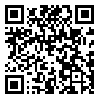1. Bertone A, Mottron L, Jelenic P, Faubert J. Enhanced and diminished visuo-spatial information processing in autism depends on stimulus complexity. Brain. 2005; 128 (10):2430-41. [
DOI]
2. Wieder S, Wachs H. Visual/Spatial Portals to Thinking, Feeling and Movement: Advancing Competencies and Emotional Development in Children with Learning and Autism Spectrum Disorders. New Jersey. Profectum Foundation; 2012.
3. Furth HG, Wachs H. Thinking goes to school: Piaget's theory in practice. Toronto. Oxford University Press; 1975.
4. Greenspan SI, Wieder S. Infant and early childhood mental health: A comprehensive, developmental approach to assessment and intervention. Washington DC. American Psychiatric Publishing; 2006.
5. Cantell MH, Smyth MM, Ahonen TP. Clumsiness in adolescence: Educational, motor, and social outcomes of motor delay detected at 5 years. Adapted physical activity quarterly. 1994;11 (2) :115-29. [
DOI]
6. Winnick J, Porretta DL. Adapted physical education and sport. Human Kinetics; 2005,pp: 359-72
7. Houwen S, Visscher C, Hartman E, Lemmink KA. Gross motor skills and sports participation of children with visual impairments. Research Quarterly for Exercise and Sport. 2007;78 (2) :16-23. [
DOI]
8. Berney T. Clinical practice guidelines: Redefining the standards of care for infants, children, and families with special needs. Journal of Child Psychology and Psychiatry and Allied Disciplines. 2002; 43 (8) :1111-32.
9. Mäntymaa M. Early mother-infant interaction: Determinants and Predictivity. Finland. Tampere University Press; 2006.
10. Barlow J, Parsons J, Stewart‐Brown S. Preventing emotional and behavioural problems: the effectiveness of parenting programmes with children less than 3 years of age. Child: care, health and development. 2005;31 (1) :33-42. [
DOI]
11. Damon W, Lerner RM, Eisenberg N, editors. Handbook of child psychology, social, emotional, and personality development. John Wiley & Sons; 2006.
12. Greenspan SI. Developmentally Based Psychotherapy. Madison, CT: International Universities Press, 1997.
13. Amin Yazdi A. Integrated Human Growth: An Evolution Developmental, individual differences, relationship- based model. Educational Research. 2011; 2 (1) : 109-26. [Persian]
14. Li X, Chan RC, Luo YJ. Stage effects of negative emotion on spatial and verbal working memory. BMC neuroscience. 2010;11 (1) :60. [
DOI]
15. Mofrad F. The Relationship between Mother-Child Relationship with Functional Emotional Development and Language Pragmatic Development in Preschool Children. [Unpublished Thesis for MSc. in psychology]. [Mashhad, Iran]: Faculty of Educational Sciences and Psychology; Ferdowsi University of Mashhad, 2011. [Persian]
16. Janfada M. The Role of maternal attachment of functional and emotional development of children with a mother's parenting style mediate children under 3.5 years. [Unpublished Thesis for MSc. in psychology]. [Mashhad, Iran]: Faculty of Educational Sciences and Psychology; Ferdowsi University of Mashhad, 2015. [Persian]
17. Dewey D, Cantell M, Crawford SG. Motor and gestural performance in children with autism spectrum disorders, developmental coordination disorder, and/or attention deficit hyperactivity disorder. Journal of the International Neuropsychological Society. 2007 ;13 (2) :246-56. [
DOI]
18. Greenspan PS. Emotions and reasons: An inquiry into emotional justification. Routledge; 2014.
19. Krejcie RV, Morgan DW. Determining sample size for research activities. Educational and psychological measurement. 1970; 30 (3):607-10. [
DOI]
20. Yousefi A. finesse on the social integration of urban space in Mashhad: the categorization of urban areas. Journal of Social Sciences Faculty of Literature and Human Sciences Ferdowsi University of Mashhad. 2010; 2: 61-91. [Persian]
21. Breinbauer C, Mancil TL, Greenspan S. The Bayley-III Social-Emotional Scale. Bayley-III Clinical Use and Interpretation; 2010, pp:147-74.
22. Wilson BN, Crawford SG, Green D, Roberts G, Aylott A, Kaplan BJ. Psychometric properties of the revised developmental coordination disorder questionnaire. Physical & occupational therapy in pediatrics. 2009;29 (2) :182-202. [
DOI]
23. Salehi H, Afsorde BR, Movahedi A, Ghasemi V. Psychometric properties of a Persian version of the developmental coordination disorder questionnaire in boys aged 6-11 year-old. Journal of Psychology of Exceptional individuals. 2012; 90: 135- 61. [Persian]
24. Pianta RC. Patterns of relationships between children and kindergarten teachers. Journal of school psychology. 1994; 32 (1) :15-31. [
DOI]
25. Abareshi Z, Tahmasian K, Mazaheri MA, Panaghi L. The Impact of Psychosocial Child Development Training Program, Done through Improvement of Mother-Child Interaction, on Parental Self-Efficacy and Relationship between Mother and Child under Three. Journal of Research in Psychological Health. 2008; 3 (3): 50-7. [Persian]
26. Zarezadeh Kheibari S, Aminyazdi A, Aali S, Kareshki H. The role of visual-spatial function in the interactive development profile of preschool children: Measurement, design and compare the effectiveness of the DIR/Floortime based on visual-spatial development and cognitive computer based interventions [Unpublished PhD. dissertation in psychology]. [Mashhad, Iran]: Faculty of Educational Sciences and Psychology; Ferdowsi University of Mashhad, 2018. [Persian]
27. Hashemzadeh Z. Investigating the theory of mind and functional emotional development in blind children of Mashhad city and comparing it with the counterparts from the perspective of the DIR approach [Unpublished Thesis for M. Sc. in psychology]. [Mashhad, Iran]: Faculty of Educational Sciences and Psychology; Ferdowsi University of Mashhad, 2015. [Persian]






